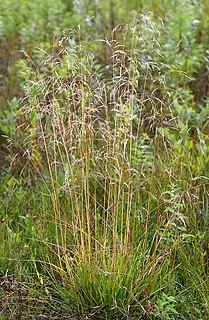
Agrostis is a large and very nearly cosmopolitan genus of plants in the grass family, found in nearly all the countries in the world. It has been bred as a GMO creeping bent grass.

Aira is a genus of Old World plants in the grass family, native to western and southern Europe, central and southwest Asia, plus Africa.

Note that information on this species applies to Western Europe and some details may not be consistent with the species in other parts of its range.

The short-tailed field vole, short-tailed vole, or simply field vole is a grey-brown vole, around 10 cm in length, with a short tail. It is one of the most common mammals in Europe, with a range extending from the Atlantic coast to Lake Baikal. These voles are found in moist grassy habitats, such as woodland, marsh or on river banks. Although they make shallow burrows, they usually build nests above ground. They are an important food source for owls and some other predators and their population size tends to peak and trough cyclically. Field voles breed prolifically, mainly in summer, but often all year round, even under snow. Females produce up to seven litters a year, each averaging from four to six young which are weaned after about fourteen days. The short-tailed field vole is both widespread and common and is listed as being of "Least Concern" by the IUCN.

Deschampsia cespitosa, commonly known as tufted hairgrass or tussock grass, is a perennial tufted plant in the grass family Poaceae. Distribution of this species is widespread including the eastern and western coasts of North America, parts of South America, Eurasia and Australia.

Deschampsia is a genus of plants in the grass family, commonly known as hair grass or tussock grass. The genus is widespread across many countries.
British NVC community MG9 is one of the mesotrophic grassland communities in the British National Vegetation Classification system. It is one of three communities associated with poorly drained permanent pastures.
Davidiella tassiana is a fungal plant pathogen infecting several hosts, including Iris barnumiae subsp. demawendica in Iran.

A species that is extinct in the wild (EW) is one that has been categorized by the International Union for Conservation of Nature as known only by living members kept in captivity or as a naturalized population outside its historic range due to massive habitat loss.
Deschampsia angusta is a species of grass in the family Poaceae. It is found in Kenya and Uganda. Its natural habitat is Alpine wetlands.
Deschampsia robusta is a species of grass in the family Poaceae. It is found on Gough Island, near Tristan da Cunha in the South Atlantic Ocean.

Bourlon's genet is a genet species native to the Upper Guinean forests. It is known from only 29 zoological specimens in natural history museum and has been described as a new Genetta species in 2003. It is listed as Vulnerable on the IUCN Red List as the global population is estimated at less than 10,000 mature individuals.

Deschampsia flexuosa, commonly known as wavy hair-grass, is a species of bunchgrass in the grass family widely distributed in Eurasia, Africa, South America, and North America.

Tussock grasses or bunch grasses are a group of grass species in the family Poaceae. They usually grow as singular plants in clumps, tufts, hummocks, or bunches, rather than forming a sod or lawn, in meadows, grasslands, and prairies. As perennial plants, most species live more than one season. Tussock grasses are often found as forage in pastures and ornamental grasses in gardens.

Hipparchia statilinus, the tree grayling, is a butterfly of the family Nymphalidae.

Deschampsia danthonioides is a species of grass known by the common name annual hairgrass. It is native to western North America from the Yukon Territory and British Columbia, through California and the Western United States, to Baja California, and also to southern South America in Chile and Argentina.

Deschampsia elongata is a species of grass known by the common name slender hairgrass.

Schismus is a genus of African and Eurasian plants in the grass family. Two species are naturalized in North America, where they are known as Mediterranean grass.

Elachista albidella is a moth of the family Elachistidae, described by William Nylander in 1848. Its wingspan ranges from 9–10 millimetres (0.35–0.39 in).The head is white. Forewings are white, costa and sometimes dorsum suffused with fuscous; plical stigma large, elongate, black ; an angulated fuscous fascia beyond middle, angle acutely produced towards apex ; small fuscous costal and dorsal spots near apex. Hindwings are rather dark grey.The larva is greenish-grey, more yellowish anteriorly; head dark brown.

Deschampsia chapmanii is a plant species in the grass (Poaceae) family, native to New Zealand and Macquarie Island.
















